209 series
| 209 series | |
|---|---|
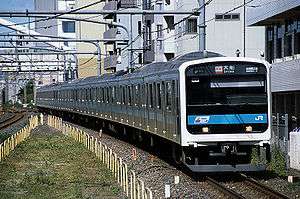 A Keihin-Tohoku Line 209 series train in October 2006 | |
| Manufacturer | JR East, Kawasaki Heavy Industries, Tokyu Car Corporation |
| Replaced | 103 series, 113 series, 211 series |
| Constructed | 1992–2004 |
| Entered service | 1993 |
| Refurbishment | 2009– |
| Number built | 1,046 vehicles |
| Number in service | 538 vehicles (as of 1 October 2016)[1] |
| Number preserved | 1 vehicle |
| Formation | 4/6/8/10 cars per trainset |
| Operator(s) | JR East |
| Depot(s) | Kawagoe, Keiyo, Makuhari, Matsudo, Mitaka, Nakahara |
| Line(s) served | Chūō-Sōbu Line, Hachikō Line, Jōban Line, Kashima Line, Kawagoe Line, Keiyō Line, Musashino Line, Nambu Line, Narita Line, Sōbu Main Line, Sotobō Line, Togane Line, Uchibō Line |
| Specifications | |
| Car body construction | Stainless steel |
| Car length | 20,000 mm (65 ft 7 in) |
| Width | 2,870 mm (9 ft 5 in) (2,966 mm (9 ft 8.8 in) for 209-500 series) |
| Doors | 4/6 pairs per side |
| Maximum speed | 110 km/h (70 mph) |
| Traction system | Variable frequency (GTO, IGBT) |
| Power output | 1,520 kW (6 motors) |
| Acceleration | 2.5 km/h/s or 3.3 km/h/s |
| Deceleration | 4.0 km/h/s (4.5 km/h/s for emergency brake) |
| Electric system(s) | 1,500 V DC overhead |
| Current collection method |
PS28 diamond-shaped pantograph PS21 diamond-shaped pantograph (209-1000 series) PS33A single-arm pantograph (209-500 series) |
| Braking system(s) | Regenerative brake, electronically controlled pneumatic brakes |
| Safety system(s) | ATS-P, ATS-SN, ATC, Digital ATC |
| Track gauge | 1,067 mm (3 ft 6 in) |
The 209 series (209系) is an electric multiple unit (EMU) commuter train type operated by East Japan Railway Company (JR East) in the Tokyo area of Japan since 1993.
The series was introduced in 1993 to replace the aging 103 series stock on the Keihin-Tohoku and Negishi lines. The concept of the 209 series was to create a low-cost, minimal lifespan train (approximately 15 years) that would be replaced rather than rebuilt when they became life-expired.[2]
The 209 series was the first of the "New series trains" (新系列電車 Shin-keiretsu densha), and served as the basis for the E501, E217, 701, and E127 series rolling stock, as well as the E231 series stock, which in turn became the blueprint for successive trains developed by JR East and other railway companies in Japan.
Operations
- Chuo-Sobu Line: 10-car 209-500 series sets (since 1998)
- Hachiko Line/Kawagoe Line: 4-car 209-3000 series (x4); 209-3100 series (x2) sets (since 1996); and 209-3500 series sets (since 2018)
- Keiyo Line: 10-car 209-500 series sets (since October 2008)
- Musashino Line: 8-car 209-500 series sets (since December 2010)
- Narita Line: 4/6-car 209-2000/2100 series sets (since October 2009)
- Sobu Main Line: 4/6-car 209-2000/2100 series sets (since October 2009)
- Sotobo Line: 4/6-car 209-2000/2100 series sets (since October 2009)
- Uchibo Line: 4/6-car 209-2000/2100 series sets (since October 2009)
Former operations
- Joban Line: 10-car 209-1000 series sets (x2) (since 1999 - October 2018)
- Keihin-Tohoku Line/Negishi Line: 10-car 209-0 series and 209-500 series (x83) (from 1993 until January 2010)
- Nambu Line: 6-car 209-0 series (from 1993 until 2015)
and 6-car 209-2200 series sets (x3) (from 2009 until March 2017)[3]
Variants
- 209-0 series (10/6-car sets)
- 209-500 series (10/8-car sets)
- 209-900 series (10-car sets)
- 209-950 series (10-car sets)
- 209-1000 series (10-car sets)
- 209-2000/2100 series (6/4-car sets)
- 209-2200 series (6-car sets)
- 209-3000 series (4-car sets)
- 209-3100 series (4-car sets)
- 209-3500 series (4-car sets)
209-0 series
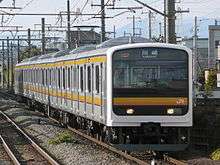
The original full-production version introduced on both the Keihin-Tohoku (ten-car sets) and Nambu (six-car sets) lines in 1993. Six-door SaHa 208 cars were inserted into the Keihin-Tohoku Line sets in 1995.
The 209 series trains on the Keihin-Tohoku/Negishi lines were replaced by new E233 series trains from autumn 2007, with the last sets withdrawn by 24 January 2010.[4] A large number of these units were subsequently rebuilt as 209-2000/2100 series four- and six-car sets for use in the Chiba area.
Formations
Nambu Line 6-car sets
The former Nambu Line six-car sets were formed as follows, with car 1 at the Kawasaki end.[5]
| Car No. | 1 | 2 | 3 | 4 | 5 | 6 |
|---|---|---|---|---|---|---|
| Numbering | KuHa 209-68 | MoHa 209-135 | MoHa 208-135 | MoHa 209-136 | MoHa 208-136 | KuHa 208-68 |
Cars 2 and 4 were each equipped with one PS28 lozenge-type pantograph.[5]
Keihin-Tohoku Line 10-car sets
The former Keihin-Tohoku Line ten-car sets were formed as follows, with car 1 at the Ofuna (southern) end.[6]
| Car No. | 1 | 2 | 3 | 4 | 5 | 6 | 7 | 8 | 9 | 10 |
|---|---|---|---|---|---|---|---|---|---|---|
| Designation | Tc' | M' | M | T | T | T' | M' | M | T | Tc |
| Numbering | KuHa 208 | MoHa 208 | MoHa 209 | SaHa 209 | SaHa 209 | SaHa 208 | MoHa 208 | MoHa 209 | SaHa 209 | KuHa 209 |
209-500 series
This sub-series represented a stop-gap for use from 1998 on the Chuo-Sobu Line until the full-production E231 series trains were delivered. The 17 ten-car sets differ noticeably from the other 209 series variants in having 2,966 mm wide cars (compared to 2,870 mm for earlier flat-sided stock), as well as LED destination indicators, replacing the earlier roller blind type. While externally similar in appearance to the later E231 series sets, the 209-500 series are distinguishable by their white cab fronts and lack of six-door cars. Five sets were transferred to the Keihin-Tōhoku Line, and, from October 2008, these were modified (with ATS-P/SN instead of ATC), repainted, and transferred to the Keiyo Line following the introduction of new E233 series trains. From September 2010, three former Keiyo Line sets were reduced to eight cars and reliveried for use on the Musashino Line, entering service from 4 December 2010.[5]
- A Chuo-Sobu Line 209-500 series train at Mitaka station in June 2005
 A Keihin-Tohoku Line 209-500 series in November 2008
A Keihin-Tohoku Line 209-500 series in November 2008 A Keiyo Line Line 209-500 series in December 2008
A Keiyo Line Line 209-500 series in December 2008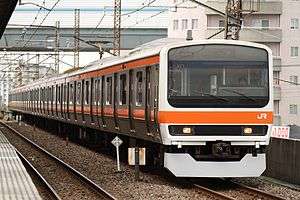 Musashino Line 209-500 series set M71 in August 2011
Musashino Line 209-500 series set M71 in August 2011
Formations
10-car sets
As of 1 October 2016, 13 ten-car sets (C501 to C512 and C516) were allocated to Mitaka Depot for use on the Chuo-Sobu Line, and one set (34) was allocated to Keiyo Depot for use on the Keiyo Line.[1] These sets are formed as follows with four motored ("M") cars and six non-powered trailer ("T") cars.[1]
| Designation | Tc | T | M | M' | T | T | T | M | M' | Tc' |
|---|---|---|---|---|---|---|---|---|---|---|
| Numbering | KuHa 209-500 | SaHa 209-500 | MoHa 209-500 | MoHa 208-500 | SaHa 209-500 | SaHa 209-500 | SaHa 209-500 | MoHa 209-500 | MoHa 208-500 | KuHa 208-500 |
The two MoHa 209 cars each have one pantograph (lozenge type on sets C501 to C509, and single-arm type on sets C510 to C516 and 34).[1]
8-car sets
As of 1 October 2016, three eight-car sets (M71 to M73) were allocated to Keiyo Depot for use on Musashino and Keiyo Line services.[1] These sets are formed as follows with four motored ("M") cars and four non-powered trailer ("T") cars.[1] Car 1 is at the Tokyo end.[1]
| Car No. | 1 | 2 | 3 | 4 | 5 | 6 | 7 | 8 |
|---|---|---|---|---|---|---|---|---|
| Designation | Tc | M | M' | T | T | M | M' | Tc' |
| Numbering | KuHa 209-500 | MoHa 209-500 | MoHa 208-500 | SaHa 209-500 | SaHa 209-500 | MoHa 209-500 | MoHa 208-500 | KuHa 208-500 |
The two MoHa 209 cars (cars 2 and 6) each have one single-arm pantograph.[1] Car 4 is designated as a mildly air-conditioned car.[1]
209-900/910/920 series
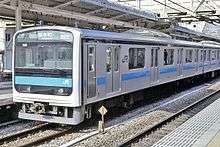
Three ten-car prototypes were built in 1992 for testing and passenger evaluation on the Keihin-Tōhoku Line, initially classified as 901 series. Set A was built by Kawasaki Heavy Industries, set B by Tokyu Car Corporation, and set C was built by Kawasaki Heavy Industries and JR East's Ōfuna factory (cars 4 and 5). The three sets incorporated a number of different design features for evaluation, but were converted in 1994 to bring them in line with the full-production specifications. Set A became 209-900 series, set B became 209-910 series, and set C became 209-920 series. They differed from the full-production 209-0 series sets in not having six-door SaHa208 cars.[7]
209-910 series set 91 was withdrawn in December 2006, and the last of the three prototype sets, set 90, was withdrawn in August 2007.[8] Car KuHa 209-901 from the original 901 series set A was stored at Nagano Works,[9] and later preserved at Tokyo General Rolling Stock Center.
 209-900 series set 90 in November 2006
209-900 series set 90 in November 2006 209-920 series set 92 in January 2007
209-920 series set 92 in January 2007
Formation
| Car No. | 1 | 2 | 3 | 4 | 5 | 6 | 7 | 8 | 9 | 10 |
|---|---|---|---|---|---|---|---|---|---|---|
| Numbering[10] | KuHa 900 | MoHa 900 | MoHa 901 | SaHa 901 | SaHa 901 | SaHa 901 | MoHa 900 | MoHa 901 | SaHa 901 | KuHa 901 |
209-950 series
This was the original classification given to the prototype E231 series 10-car set delivered in October 1998. It was reclassified as E231-900 series in June 2000 following conversion to the full-production E231 standard.[11]
209-1000 series
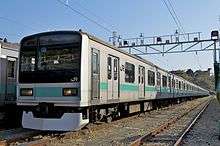
Two 10-car sets (81 and 82) were delivered from Tokyu Car Corporation in August and September 1999, entering service from 4 December 1999 on Joban Line and Tokyo Metro Chiyoda Line inter-running services. Based on the 209-0 series, these trains have end doors for use in emergencies inside tunnels. These sets are based at JR East's Matsudo depot. These train sets will be withdrawn from the Joban Line and be reallocated to the Chūō Line (Rapid) by December 2018. They will be based at JR East's Toyoda Depot after the reallocation.
Formation
| Car No. | 10 | 9 | 8 | 7 | 6 | 5 | 4 | 3 | 2 | 1 |
|---|---|---|---|---|---|---|---|---|---|---|
| Numbering | KuHa 209-1000 | MoHa 209-1000 | MoHa 208-1000 | SaHa 209-1000 | MoHa 209-1000 | MoHa 208-1000 | SaHa 209-1000 | MoHa 209-1000 | MoHa 208-1000 | KuHa 208-1000 |
Cars 3, 6, and 9 are fitted with PS21 lozenge type pantographs.[12]
- Jōban Line 209-1000 series interior view in August 2007
- Priority seating in November 2010
209-2000/2100 series
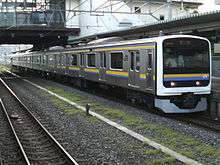
These are four- and six-car sets based at Makuhari Depot modified in 2009 from former Keihin-Tohoku Line 209-0 series ten-car sets for use on Chiba area and Bōsō Peninsula local services from 1 October 2009. The first four-car set was outshopped from Nagano Works in June 2009. Modifications include new electrical equipment, the addition of transverse seating, LED destination indicator panels, and a toilet.[13] The cars are numbered in the -2100 series, although some four-car sets have end cars numbered in the -2000 series. The -2000 series cars are converted from early batch 209-0 series units with air-operated doors rather than the electrically-operated doors of later batch units.[14]
As of October 2016, 42 four-car sets and 26 six-car sets were in service.[1][5]
4-car formation
| Car No. | 1 | 2 | 3 | 4 |
|---|---|---|---|---|
| Numbering | KuHa 208-2000/2100 | MoHa 208-2100 | MoHa 209-2100 | KuHa 209-2000/2100 |
- The end cars have some transverse seating bays.
- Car 2 is fitted with a toilet.
- The MoHa 209-2100 cars are fitted with one lozenge-type pantograph.
The first six-car set, C602, was outshopped from Ōmiya Works in July 2009.[5]
6-car formation
| Car No. | 1 | 2 | 3 | 4 | 5 | 6 |
|---|---|---|---|---|---|---|
| Numbering | KuHa 208-2100 | MoHa 208-2100 | MoHa 209-2100 | MoHa 208-2100 | MoHa 209-2100 | KuHa 209-2100 |
- The end cars have some transverse seating bays.
- Car 2 is fitted with a toilet.
- The MoHa 209-2100 cars are each fitted with one lozenge-type pantograph.
 Interior of 209-2100 series car with transverse seating in June 2012
Interior of 209-2100 series car with transverse seating in June 2012 Toilet of a 209-2100 series set
Toilet of a 209-2100 series set
209-2200 series
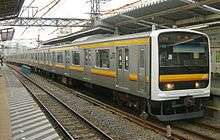
These were six-car sets reformed in 2009 from former Keihin-Tohoku Line 209-0 series ten-car sets for use on Nambu Line services, replacing the early-batch 209-0 series set and a 205-1200 series set.[15] The first set, number 52, was outshopped in May 2009, and entered service on 12 June 2009.[16] Modifications include new electrical equipment and the addition of LED destination indicator panels.[17]
The last remaining 209-2200 series trainset, set 53, was replaced from 15 March 2017.[18]
Formation
The 209-2200 series sets were formed as follows, with car 1 at the Kawasaki end.[1]
| Car No. | 1 | 2 | 3 | 4 | 5 | 6 |
|---|---|---|---|---|---|---|
| Numbering | KuHa 209-2200 | MoHa 209-2200 | MoHa 208-2200 | MoHa 209-2200 | MoHa 208-2200 | KuHa 208-2200 |
Cars 2 and 4 were each equipped with a PS28A single-arm pantograph.[1]
209-2200 series "B.B.Base"
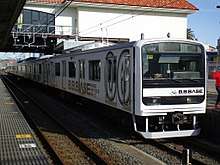
This is a former Nambu Line 209-2200 series set (Naha 53) specially modified during 2017 for use as a train for carrying cyclists and their bicycles from Ryogoku in Tokyo to various destinations on the Uchibo Line, Sotobo Line, Narita Line, and Sobu Main Line on the Boso Peninsula. Branded "B.B.Base" (an abbreviation for "Boso Bicycle Base"), it entered service on 6 January 2018.[19]
Formation
The 209-2200 series "B.B.Base" set is formed as follows, with car 1 at the Ryogoku (western) end.[19]
| Car No. | 1 | 2 | 3 | 4 | 5 | 6 |
|---|---|---|---|---|---|---|
| Numbering | KuHa 208-2202 | MoHa 208-2204 | MoHa 209-2204 | MoHa 208-2203 | MoHa 209-2203 | KuHa 209-2202 |
| Weight (t) | 27.2 | 31.9 | 29.6 | 33.1 | 29.6 | 27.5 |
| Seating capacity | 20 | 19 | 20 | - | 20 | 20 |
Cars 3 and 5 each have one PS33F single-arm pantograph.[19] Cars 1 to 3 and 5 to 6 have fixed seating bays arranged 2+1 abreast with cycle racks provided next to each of the doorways, while car 4 has an open configuration with bench seating on one side and a bar counter. Wheelchair-accessible toilets are provided in cars 2 and 4.[19]
209-3000 series
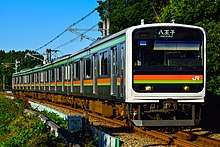
Four four-car 6th-batch sets were introduced on 16 March 1996 for use on the Kawagoe Line and newly electrified southern section of the Hachikō Line. These sets (numbers 61 to 64) are based at JR East's Kawagoe depot.[20] While visually similar to the original 209-0 sub-series, these sets differ in having passenger-operated door controls.[11]
For a short period in 2004, KuHa 209-3003 of set 63 was fitted with transverse seating bays to increase seating capacity. It was later reverted to standard longitudinal bench seating.[11]
Between February and March 2007, some of the previously sealed windows in each car were modified to allow them to be opened.[11]
Formation
The four sets, 61 to 64, are formed as shown below, with car 1 at the Komagawa end and car 4 at the Kawagoe end.[21]
| Car No. | 1 | 2 | 3 | 4 |
|---|---|---|---|---|
| Designation | Tc' | M' | M | Tc |
| Numbering | KuHa 208-3000 | MoHa 208-3000 | MoHa 209-3000 | KuHa 209-3000 |
Car 3 is fitted with one PS28 lozenge-type pantograph.[21]
Build details
| Set | Manufacturer | Date delivered |
|---|---|---|
| 61 | Kawasaki Heavy Industries | January 1996 |
| 62 | Tokyu Car Corporation | January 1996 |
| 63 | Tokyu Car Corporation | February 1996 |
| 64 | Tokyu Car Corporation | February 1996 |
209-3100 series
This sub-series of two four-car sets was introduced on 17 April 2005 as part of the scheme to eliminate 103 series sets from the Kawagoe Line and Hachiko Line.[22] Set number 71 consists of two former TWR 70-000 series control cars with two newly manufactured intermediate cars, while set number 72 consists entirely of former 70-000 series cars. The 70-000 series cars had become surplus when six-car sets were reformed into ten-car sets in 2004. Like the 209-3000 series, these sets have passenger-operated door controls.[11]
Formation
The two sets, 71 and 72, are formed as shown below, with car 1 at the Komagawa end and car 4 at the Kawagoe end.[21]
| Car No. | 1 | 2 | 3 | 4 |
|---|---|---|---|---|
| Designation | Tc' | M' | M | Tc |
| Numbering | KuHa 208-3100 | MoHa 208-3100 | MoHa 209-3100 | KuHa 209-3100 |
Car 3 is fitted with one PS28 lozenge-type pantograph.[21]
Former TWR 70-000 series conversions
The identities of the six former 70-000 series cars converted in 2004 and 2005 to become 209-3100 series EMUs are as shown below.[21]
| Car number | Set number | Former car number | Date returned to traffic |
|---|---|---|---|
| KuHa 209-3101 | 71 | 70-020 | 14 March 2005 |
| KuHa 208-3101 | 71 | 70-029 | 14 March 2005 |
| KuHa 209-3102 | 72 | 70-030 | 16 December 2004 |
| MoHa 209-3102 | 72 | 70-027 | 16 December 2004 |
| MoHa 208-3102 | 72 | 70-028 | 16 December 2004 |
| KuHa 209-3102 | 72 | 70-039 | 16 December 2004 |
209-3500 series
From 2018, former 209-500 series ten-car sets based at Mitaka Depot for use on Chuo-Sobu Line services were reformed and converted to become four-car 209-3500 series sets based at Kawagoe for use on Kawagoe Line and Hachiko Line services.[23]
Formation
| Car No. | 1 | 2 | 3 | 4 |
|---|---|---|---|---|
| Designation | Tc' | M' | M | Tc |
| Numbering | KuHa 208-3500 | MoHa 208-3500 | MoHa 209-3500 | KuHa 209-3500 |
Former set identities
The former identities of the 209-3500 series sets are as follows.[24]
| Set No. | Former set No. |
|---|---|
| 51 | C501 |
Training sets
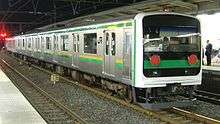
Shirakawa
A purpose-built four-car set based directly on the 209-0 series design and classified E991 series was delivered to JR East's training centre in Shirakawa, Fukushima in 2000 for internal training use. Externally, it is finished in shōnan green/orange stripes on unpainted stainless steel.
Ōmiya
A two-car set was converted from former Keihin-Tohoku Line end cars in 2008 for use as a staff training set at JR East's Ōmiya Training Center. This replaced the former 103 series two-car set previously used there. The set is formed of KuMoHa209-76 + KuMoHa208-76, and is finished in the shōnan green/orange colour scheme.[25]
Yokohama
Another two-car set was converted from former Keihin-Tohoku Line end cars at Nagano Works, and moved to the JR East Yokohama area training centre next to Kurihama Station in July 2008, replacing the 105 series 2-car set previously used there. The set is formed of KuMoHa 209-092 + KuMoHa 208-092, converted from former intermediate cars MoHa209-39 + MoHa208-39, with cabs newly added, and features pale yellow bodyside stripes bearing the lettering "YOKOHAMA Training Center".[26]
Hachiōji
A third two-car set was converted from former Keihin-Tohoku Line end cars at Nagano Works, and moved to the JR East Hachiōji area training centre next to Shin-Akitsu Station in October 2008, replacing the 105 series two-car set previously used there. The set features orange bodyside stripes bearing the lettering "HACHIOJI Training Center".[27]
MUE-Train
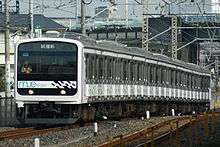
In October 2008, JR East unveiled the seven-car "MUE-Train" (MUltipurpose Experimental Train) experimental EMU converted from former Keihin-Tohoku Line 209 series cars. This set is used to test and develop new technology for use on future narrow-gauge trains. The train is based at Kawagoe Depot and began testing on the Utsunomiya Line from November 2008.[28]
Formation
2008 - 2009
| Car No. | 1 | 2 | 3 | 4 | 5 | 6 | 7 |
|---|---|---|---|---|---|---|---|
| Numbering | KuYa 208-2 | MoYa 208-4 | MoYa 209-4 | SaYa 209-8 | MoYa 208-3 | MoYa 209-3 | KuYa 209-2 |
2010 onward
| Car No. | 1 | 2 | 3 | 5 | 6 | 7 |
|---|---|---|---|---|---|---|
| Numbering | KuYa 208-2 | MoYa 208-4 | MoYa 209-4 | MoYa 208-3 | MoYa 209-3 | KuYa 209-2 |
Cars 3 and 6 are each fitted with one PS33D single-arm pantograph.[12]
Preserved examples
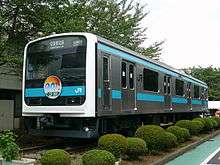
- KuHa 901-1 (previously KuHa 209-901), at the Tokyo General Rolling Stock Center in Shinagawa, Tokyo[29]
References
- JR全車輌ハンドブック2006 [JR Rolling Stock Handbook 2006]. Japan: Neko Publishing. 2006. ISBN 978-4-7770-0453-9.
- 1 2 3 4 5 6 7 8 9 10 11 12 Jr電車編成表 JR電車編成表 2017冬 [JR EMU Formations - Winter 2017] (in Japanese). Japan: Kotsu Shimbunsha. 16 November 2016. pp. 49, 54–55, 93, 95, 410. ISBN 978-4-330-73716-4.
- ↑ "We must create our own core competences". Railway Gazette International. 1 October 1999. Retrieved 18 May 2009.
- ↑ "JR旅客会社の車両配置表". Japan Railfan Magazine (591): Appendix p. 9. July 2010.
- ↑ 京浜東北線・根岸線209系引退で記念イベント. Hobidas (in Japanese). 14 December 2009. Retrieved 14 December 2009.
- 1 2 3 4 5 JR電車編成表 2013夏 [JR EMU Formations - Summer 2013]. Japan: Kotsu Shinbunsha. May 2013. pp. 47, 52–53. ISBN 978-4-330-37313-3.
- 1 2 3 JR電車編成表 '02夏号 [JR EMU Formations - Summer '02]. Japan: JRR. June 2002. pp. 60–62. ISBN 978-4-88283-037-5.
- ↑ プロトタイプの世界 - Prototype World. Japan: Kōtsū Shimbunsha. December 2005. OCLC 170056962.
- ↑ 鉄道友の会 東京支部 JR電車部会 (December 2007). "京浜東北線を駆け抜けた車両たち 後編". Japan Railfan Magazine. 48 (562): 77–84.
- ↑ クハ209-901,長野総合車両センター構内に. Japan Railfan Magazine (in Japanese). 29 July 2009. Retrieved 8 August 2009.
- ↑ 日本と世界の鉄道カタログ [Japan and World Railway Catalogue]. Japan: Seibido Publishing. July 1992. pp. 60–61. ISBN 978-4-415-03262-7.
- 1 2 3 4 5 鉄道友の会 東京支部 JR電車部会 (April 2009). 特集 209系 第2章へ [209 series - The second chapter]. Japan Railfan Magazine. 49 (576): 9–47.
- 1 2 JR電車編成表 2010夏 [JR EMU Formations - Summer 2010]. Japan: Kotsu Shinbunsha. May 2010. ISBN 978-4-330-14310-1.
- ↑ 209系2100番台,配給輸送される. Japan Railfan Magazine (in Japanese). 14 June 2009. Retrieved 15 June 2009.
- ↑ 209系転用改造車 [209 series modified units]. Japan Railfan Magazine (in Japanese). 49 (583): 58–62. November 2009.
- ↑ 209系転用計画の全貌. Japan Railfan Magazine (in Japanese). 49 (583): 63–73. November 2009.
- ↑ 209系2200番台が営業運転を開始. Japan Railfan Magazine (in Japanese). 16 June 2009. Retrieved 16 June 2009.
- ↑ "Archived copy" 209系2200番台,東京総合車両センターを出場. Japan Railfan Magazine (in Japanese). 15 May 2009. Archived from the original on 17 May 2009. Retrieved 15 May 2009.
- ↑ JR南武線、全車両「E233系」に統一へ 青梅・五日市線から6両転属 [JR Nambu Line to be standardized with fleet of E233 series following transfer of 6 cars from Ome/Itsukaichi Line]. tetsudo-shimbun.com (in Japanese). Japan: Tetsudo Shimbun. 26 January 2017. Archived from the original on 26 January 2017. Retrieved 26 January 2017.
- 1 2 3 4 209系「B.B.BASE」 [209 series "B.B.Base"]. Japan Railfan Magazine (in Japanese). Vol. 58 no. 683. Japan: Koyusha Co., Ltd. March 2018. p. 70-71.
- ↑ JR電車編成表 '07冬号 [JR EMU Formations - Winter 2007]. Japan: JRR. December 2006. ISBN 978-4-88283-046-7.
- 1 2 3 4 5 JR電車編成表 2012夏 [JR EMU Formations - Summer 2012]. Japan: Kotsu Shinbunsha. May 2012. pp. 67, 408. ISBN 978-4-330-28612-9.
- ↑ 川越線に209系3100代を投入 103系を置換え [209-3100 series introduced on Kawagoe Line - Replacing 103 series]. Railway Journal. Japan. 39 (465): 106. July 2005.
- ↑ 八高線用の209系3500番台が配給輸送される [Hachiko Line 209-3500 series transferred]. Japan Railfan Magazine Online (in Japanese). Japan: Koyusha Co., Ltd. 19 January 2018. Archived from the original on 20 January 2018. Retrieved 20 January 2018.
- ↑ 八高線用の209系3500番台が試運転 [Hachiko Line 209-3500 series undergoes test-running]. Japan Railfan Magazine Online (in Japanese). Japan: Koyusha Co., Ltd. 21 February 2018. Archived from the original on 21 February 2018. Retrieved 21 February 2018.
- ↑ "(untitled)". Japan Railfan Magazine (in Japanese). 48 (567): 96. July 2008.
- ↑ 横浜総合訓練センターにも新訓練車登場 [New training set for Yokohama Training Center] (in Japanese). 13 August 2008. Archived from the original on 17 September 2008. Retrieved 28 August 2008.
- ↑ 八王子総合訓練センターにも209系訓練車 [209 series training set for Hachiōji Training Center too] (in Japanese). 12 October 2008. Retrieved 13 October 2008.
- ↑ 在来線用試験電車MUE-Train (ミュートレイン)について (PDF) (in Japanese). 7 October 2008. Retrieved 7 October 2008.
- ↑ Sasada, Masahiro (September 2012). 国鉄&JR保存車大全 [JNR & JR Preserved Rolling Stock Complete Guide]. Tokyo, Japan: Ikaros Publications Ltd. p. 127. ISBN 978-4863206175.
Further reading
- 首都圏新系列車両 Profile: 209/E231/E233系グループの全貌 首都圏新系列車両PROFILE [Tokyo Area New-generation Rolling Stock Profile]. Japan: Ikaros Publishing. 15 April 2011. ISBN 978-4-86320-436-2.
External links
| Wikimedia Commons has media related to 209 series. |
- JR 209 series (in Japanese)